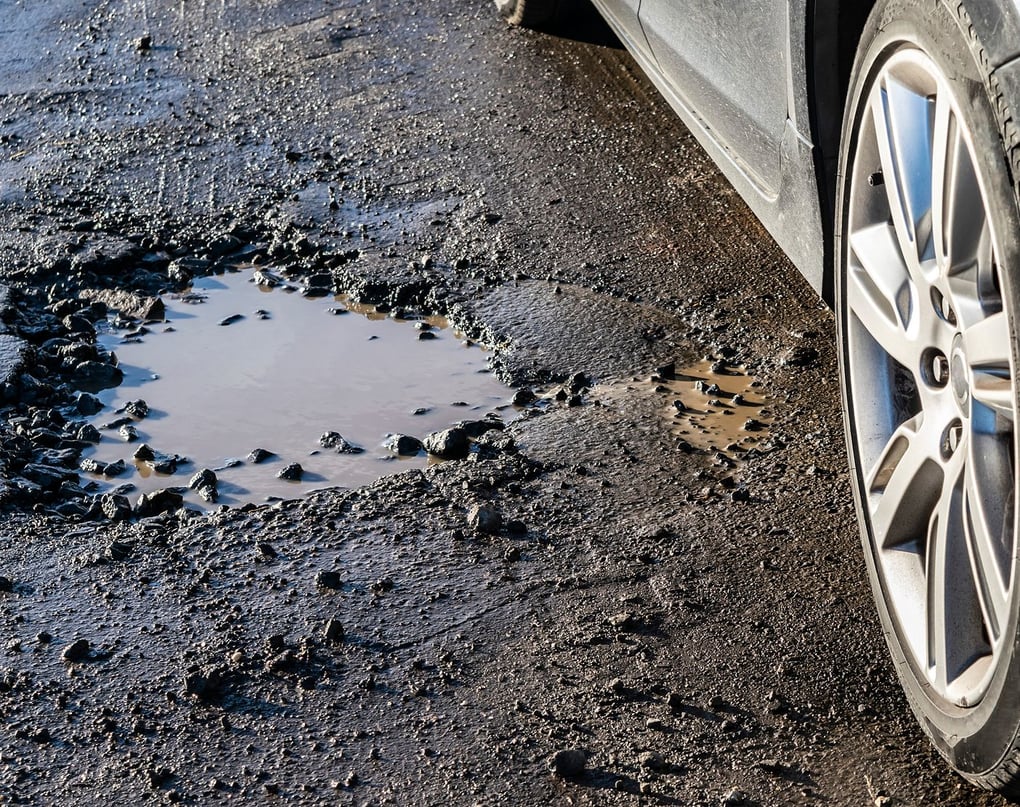It's winter time and that means pothole season is underway.
Potholes become a real issue in areas that experience extreme weather like the heavy rains, flooding, record snowfall and historically low temps. You're also likely to see more of them during the first few months of the year when temps fluctuate between hot and cold. The freezing and thawing cycles allow moisture to seep into the road surface, which causes the road to crumble.
If you hit one, you can wind up with a costly repair. A previous American Automobile Association study found that 1 in 10 drivers who hit a pothole in 2021 sustained damage significant enough to need vehicle repairs. The average price tag for each repair - almost $600. AAA says vehicle-related damage from potholes cost U.S. drivers $26.5 billion in 2021 alone.
The good news is that more automakers are introducing available technology that can detect uneven road surface conditions like potholes and things like speed bumps, and alert drivers.
But there are things drivers can do as well to help avoid potholes and costly repairs. State Farm shares these tips and additional info:
-
- Pump it up. State Farm reminds us that keeping our tires properly inflated may reduce damage. You really don't want under-inflated tires if you hit a pothole since the impact is much more likely to cause damage to tires, rims and suspension.
- Slow down. Always travel at a safe speed for the road condition and keep your eyes on the road. Doing both will help you avoid the damage that can come with hitting a pothole.
- Stay in your lane. If you see a pothole ahead, avoid sudden swerving to avoid it because you could lose control of your vehicle
- Pay it forward. If you notice a road that has potholes, you can report the roadway hazard to your local city or county transportation department so they are aware of the issue.
- Pump it up. State Farm reminds us that keeping our tires properly inflated may reduce damage. You really don't want under-inflated tires if you hit a pothole since the impact is much more likely to cause damage to tires, rims and suspension.
How do I know if a pothole caused damage?
State Farm says signs of pothole damage might include a pulling sensation in one direction, dents in your tires or rims, or low tire pressure.
Is damage from potholes covered by insurance?
State farm says pothole damage is usually covered with collision coverage, minus the deductible. Since the pothole damage your vehicle may incur could fall below the amount of your deductible, typically $500 or $1,000, it may not always be practical to file a claim. Of course everyone's policy varies so CarPro recommends checking with your insurance company to see the specifics of your policy.
Can I get paid by my city or state for pothole damage?
State Farm says some cities, counties, or states may pay for pothole damage in certain cases. You'll need to first determine which jurisdiction is responsible for the road with the pothole, then ask about any compensation available for damage. Remember to always take photos of the damage and if you can do so safely, the pothole. State Farm also recommends getting an estimate or two and filing them with the claim. There could be a time limit to file one, so you don't want to wait.
REPORTING POTHOLES in CarPro Radio Show Markets
Some cities like Houston have a pothole tracker. Portland, Oregon has one too, You can report potholes in Fort Worth, Texas here. In Dallas, to report a pothole, call 311 when dialing from inside the city limits or (214) 670-5111 when dialing from outside the city limits. Hazardous potholes are repaired with 24 hours.
Report pothole issues in Granbury, Texas, here. The city of Lubbock, Texas has an app you can use, or you can call 311. For pothole reporting info in Abilene, TX click here.
Here's where you can find pothole into for Austin, San Antonio, Sacramento, CA and Montgomery, AL. If you live in Los Angeles, you can report pothole damage here.
In Atlanta, call 311 to report one in your neighborhood. Click here for more info.
In the DC area you can also report one at 311 - click here for info and a pothole map. To report potholes in Hagerstown, MD click here.

